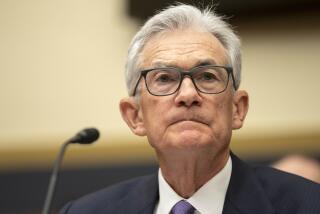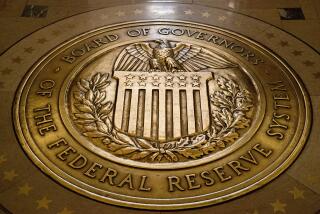Fed keeps stimulus intact as it awaits further gains in recovery
WASHINGTON — The Federal Reserve kept intact its large-scale campaign to stimulate the economy, saying it was awaiting more evidence of sustainable progress in the recovery.
Although the Fed’s decision Wednesday to hold the line on its monthly $85-billion bond-buying stimulus was widely expected, the central bank’s statement revived the idea on Wall Street that policymakers could still make a reduction of the bond purchases by year’s end.
A first cut in the Fed’s stimulus program, which has helped to drive down long-term interest rates, is likely to be small and in itself not a big deal.
But that prospect has had a powerful psychological effect that has shaken global financial markets, which have long depended on a flood of cheap cash generated by the easy-money policies of central banks, led by the Fed.
Before Wednesday, most analysts had written off a tapering of the Fed’s bond-buying program until next year, especially after the mediocre U.S. job growth in September and the 16-day partial federal government shutdown that crimped economic output and clouded the outlook.
But Fed officials, in their statement issued at the conclusion of a two-day meeting, offered a better-than-expected evaluation of the economy.
They did not downgrade their view of the recovery, repeating the September characterization of economic activity as “moderate.” The Fed did not directly mention the effect of the government shutdown this month, although it said fiscal policy was “restraining economic growth.”
Nor did the Fed lower its assessment of the labor market, despite the disappointing hiring in September and fresh signs Wednesday that business hiring weakened this month.
Moreover, in what analysts viewed as perhaps the most significant change in Wednesday’s statement from the September release, Fed officials erased a phrase citing risks from the “tightening of financial conditions” — a reference to a jump in mortgage rates over the summer that pinched the housing market.
Mortgage rates have come back down some since the previous meeting in September.
“If officials are trying to downplay the impact of the shutdown and are happier with the level of long-term interest rates, then perhaps a December taper isn’t quite as out of the question as we had previously thought,” said Paul Ashworth, chief U.S. economist at Capital Economics, in a note to clients Wednesday.
The Fed’s last monetary policy meeting this year is scheduled for Dec. 17-18. Ashworth and many other analysts still think that policymakers will wait until early next year before starting a withdrawal of the bond-buying, but they aren’t as confident as they had been.
The December meeting is expected to be the last one in which Fed Chairman Ben S. Bernanke will give a news conference as the central bank’s leader, and he may look to use the occasion to make a move and fully explain the Fed’s policy change, said Chris Rupkey, chief financial economist at the Bank of Tokyo-Mitsubishi in New York.
Bernanke’s term as chairman expires in January; President Obama has nominated the Fed’s vice chair, Janet L. Yellen, to succeed Bernanke.
“If he wants to lay the groundwork for his successor on a policy exit, you would think he would start the process,” Rupkey said of Bernanke.
Fed officials, for their part, have stressed that any policy change would depend on the economic data, particularly the numbers on employment and inflation — the two primary concerns of the central bank. The bond purchases “are not on a preset course,” the Fed reiterated Wednesday.
Stocks dropped after the Fed’s announcement, and bond yields rose a bit — indications that investors may have raised the odds of a tapering in December.
But the changes were small as the Fed largely delivered on market expectations, unlike the surprise decision after the previous meeting in September when policymakers stunned financial markets by holding off on a then highly anticipated reduction of the bond purchases.
Since then, the economic picture appears to have dimmed a bit, or at least become more muddled.
Many experts and Bernanke believe the government shutdown this month cut as much as half a percentage point from economic output in the fourth quarter, slowing an already slow-growing economy. The political battle hurt consumer confidence, and probably affected hiring as well.
Payroll processor Automatic Data Processing Inc. said Wednesday that its study showed the private sector added just 130,000 net new jobs this month, below the 150,000 average monthly job growth over the previous year.
Hiring in the service sector fell in October, said Mark Zandi, chief economist at Moody’s Analytics, which assists ADP in the monthly report.
“The government shutdown and debt-limit brinkmanship hurt the already softening job market in October,” Zandi said, noting that firms that do government contracting were affected by the shutdown and that the fiscal impasse probably caused small companies to hold off on hiring.
Zandi estimated that the Labor Department would report next week that the economy added just 100,000 net new jobs in October. The report’s release was delayed a week by the shutdown. The economy added 148,000 jobs in September, down from 193,000 in August.
“I don’t think the Federal Reserve board members would feel very comfortable [about tapering] until the job growth is closer to 200,000” a month, Zandi said.
What’s more, a government report Wednesday showed consumer prices in September continued to hover below the Fed’s 2% inflation target, adding to the uncertainties likely to give the central bank pause in changing course.
In the months ahead, private analysts and Fed officials see consumer prices rising toward the 2% target, but the drift down in September will probably add to some concern about inflation being too low.
Some officials would prefer higher inflation as that can lift business profits, conceivably allowing them to raise wages more easily. Inflation also can help lower the real cost of paying down debt, for consumers and governments alike.
All in all, Michael Gapen, an economist at Barclays Bank, doesn’t think the economic data will be strong enough in the coming weeks for the Fed to make a move in December.
Moreover, there’s another fight looming early next year over federal government funding and the debt limit.
“I think it would be a risk factor,” Gapen said. “If [the Fed] sees further political brinkmanship and that it is potentially destabilizing, it will likely choose to wait.”








